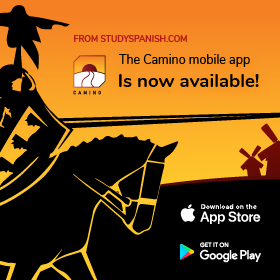Cultural Notes
-
Topics
- A Jungle Hike Through Shuar Country
- Asturias, the Natural Paradise of Spain
- Camels in South America (new)
- Caño Negro Wildlife Refuge
- Canopy Walking
- Celestún
- Cervantes
- El Chimborazo
- Christmas Eve and Christmas Day
- Christmas Time
- Climbing Cotopaxi
- Courtyards of Latin America
- Covadonga, un Santuario Histórico
- Crucifix Art in Latin America
- Cuzco
- Eating Street Food In Mexico
- Ecolodge Pioneers in Chiapas, Mexico
- El Greco
- The Sack Man
- La Sidra de Manzana; Deliciosa Tradición
- Floating Islands of Uros (ADVANCED LEVEL)
- Friends of Teacapán
- Las tortugas de caparazón gigante
- Guanajuato
- Guelaguetza
- Huichol Yarn Paintings
- Las cataratas de Iguazú
- Kings Day
- La Alhambra de Granada (ADVANCED LEVEL)
- La Tovara
- Laguna Quilotoa
- The Houses of the Indianos
- Lima
- Machu Picchu
- Madrid
- Mangroves of Pacific Mexico
- Mazatlan Aquarium
- Meet Minnie
- Mexican Cemetery Walk
- Monarch Butterfly Sanctuary Michoacán Mexico
- Morning in Teacapán
- El perro de monte
- Nopal
- Old Year
- Paella
- Papallacta Hot Springs
- La Piñata
- Quetzaltenango
- Ride the Bus in Mexico
- Running with the Tarahumara
- Salvador Dalí
- San Blas
- Sculptures In Leather
- Spanish Culture
- Spray Paint Art
- Las tiendas
- Studying Spanish in Latin America
- El tango
- Techos de México
- Teitos of Somiedo - Asturias
- Termites
- El Álamo
- Andean Condor (new)
- The Animal Carvings of Oaxaca - alebrijes
- The Bakeries of Mexico
- The Black Pottery of San Bartolo Coyotepec
- The Bronze Sculptures of Alejandro Colunga
- Cabrales Cheese Festival (new)
- The Cardón Cactus
- The Cenotes Of Yucatan
- Los conquistadores
- The Copper Work Of Santa Clara del Cobre
- The Island of Janitzio
- The Meat Markets of Mexico
- La Noche de San Juan
- The Night of the Radishes
- The Paramo
- The Plazas of Mexico
- The Ruins of Palenque
- El perezoso
- The Spirit of Angangueo
- The Textile Market of Otavalo
- The Vizcaino Desert
- The Water Boils - Hierve el agua
- La península de Yucatán
Lima
Lima
Most of our cultural notes include audio. A few are abbreviated and do not have audio.
Abbreviated Cultural Note
Lima
Lima, the capital of Peru, is located on the south bank of the Rímac River at a height of 512 feet above sea level. The city is the commercial and industrial center of the country. Sebastian Salazar Bondy wrote the book “Lima the Horrible” because of the many socioeconomic problems that plagued the city during the 1950s and the 1960s. A large migration from the countryside into the city has resulted in large numbers of street vendors and a high rate of unemployment. Today, the city of Lima is recovering its old image.
Lima
Lima, la capital del Perú, está situada en la orilla sur del Río Rímac a una altura de 156 metros sobre el nivel del mar. Es el centro comercial e industrial del país. Sebastián Salazar Bondy escribió el libro “Lima la Horrible” por sus múltiples problemas socioeconómicos que soportó durante la década del 50 al 60. El flujo migratorio del campo a la ciudad originó el comercio ambulatorio y la desocupación. Actualmente, la Municipalidad de Lima ha recuperado la vieja imagen de la Lima de los “Virreyes,” para el turismo nacional e internacional.
Comprensión
- ¿Qué escribió Salazar Bondy?
- ¿Lima tuvo flujo migratorio?
- ¿Sobre qué río está la ciudad de Lima?

